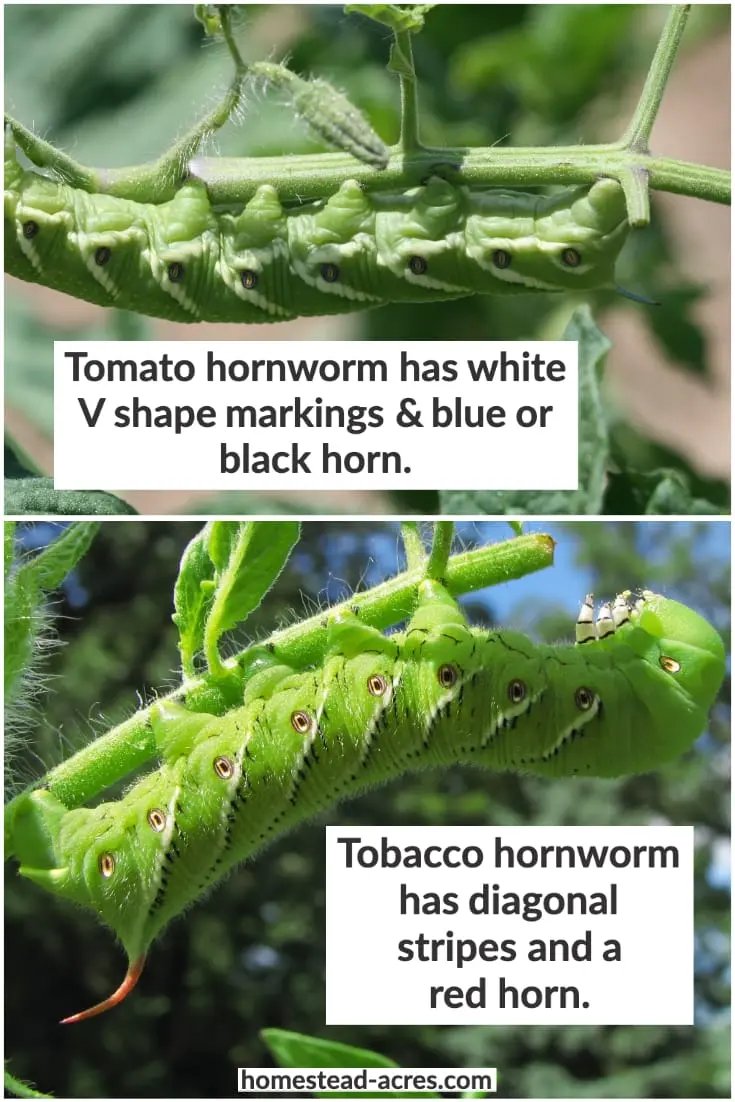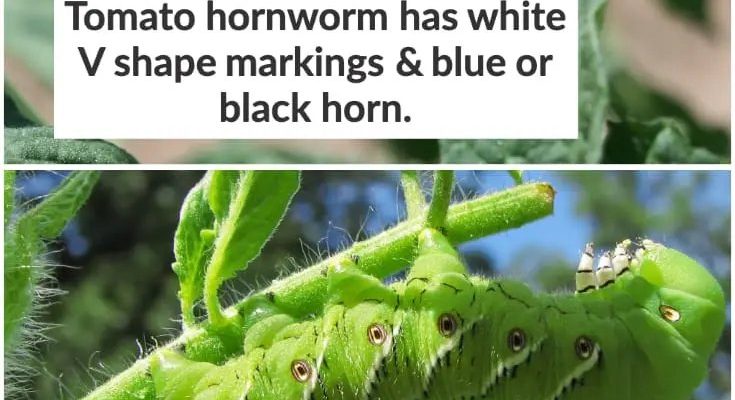
Imagine sitting in your garden, sipping coffee, and spotting a hornworm on your prized tomato plant. At first, you might think all hornworms are the same, but that’s not the case. Tobacco hornworms and Tomato hornworms have unique traits, behaviors, and even consequences for your garden. Understanding these differences not only helps you identify them but also empowers you to take the right steps to keep your plants happy and healthy.
So, let’s dive into the world of hornworms and figure out what sets these two apart.
What Are Tobacco Hornworms?
Tobacco hornworms, scientifically known as *Manduca sexta*, are the larvae of the Five-spotted Hawk Moth. They typically have a vivid green color, making them blend in with the foliage. These hornworms can grow up to 4 inches long and are known for their distinctive features: they have a horn-like projection on their rear and a set of diagonal white stripes running along their sides.
Here’s the thing: Tobacco hornworms primarily feed on tobacco plants but aren’t picky eaters. If tobacco is scarce, they will happily dine on other nightshades, including tomatoes, eggplants, and peppers. This flexibility can cause trouble for gardeners, especially if you’re growing multiple types of plants.
Their appetite is insatiable. A single Tobacco hornworm can devour a large amount of foliage in a short time. As they munch away, they not only damage leaves but can also threaten the overall health of the plant. If you’re growing tobacco, be vigilant during the warmer months, as that’s when these pests are most active.
Life Cycle of Tobacco Hornworms
Understanding the life cycle of Tobacco hornworms can help you anticipate their presence in your garden. These creatures usually emerge in the late spring or early summer from pupae that overwinter in the soil. Once they hatch, the tiny larvae start feasting on your plants right away.
After several weeks of eating and growing, they hit the stage where they need to transform. They will seek out a place to pupate, often burying themselves in the soil. The pupal stage can last a few weeks, after which adult moths emerge to start the cycle all over again. Knowing this cycle can help you plan your pest management strategies and protect your plants effectively.
What Are Tomato Hornworms?
Now, let’s shift our focus to Tomato hornworms, scientifically known as *Manduca quinquemaculata*. Similar in appearance to their tobacco-eating cousins, they also sport a bright green hue and can grow to roughly the same size. However, there are subtle differences to look out for—mainly their behavior and feeding habits.
Tomato hornworms are notorious for their love of, you guessed it, tomatoes! However, they can also relish other nightshade plants. Their presence can be just as damaging to your garden, especially if you’ve invested time and effort in growing delicious tomatoes. They tend to appear in later summer, so a keen eye is necessary during this time.
Interestingly, Tomato hornworms have a slightly different feeding pattern compared to Tobacco hornworms. They tend to focus on the leaves and the fruits, making them a bigger concern if you notice bites on your tomatoes. Addressing their presence quickly can save your crop from significant damage.
Life Cycle of Tomato Hornworms
A Tomato hornworm’s life cycle mirrors that of the Tobacco hornworm, with adult moths emerging in late spring. After hatching, the larvae rapidly grow and feed on your plants until they’re ready to pupate.
They will search for soil to bury themselves and complete their transformation into hawk moths. Tomato hornworms are particularly active during warm summer months, so awareness during this period is key to keeping them at bay. If left unchecked, they can cause considerable harm to your tomato plants.
Physical Differences Between Tobacco and Tomato Hornworms
If you’re trying to identify whether a hornworm is a Tobacco or Tomato hornworm, look closely at their physical features. While they may look similar at first glance, there are some key differences that can help you distinguish between the two.
– **Color and Markings**: Tobacco hornworms will have a series of diagonal white stripes along their sides, while Tomato hornworms have a more uniform green coloration with a V-shaped mark on the back.
– **Horn Shape**: The horn on the Tobacco version is typically more pronounced, whereas the Tomato hornworm’s horn is more subtle.
These details can seem small, but they’re critical when it comes to identifying which hornworm you’re dealing with and how to tackle the problem.
Feeding Habits and Damage
Feeding habits of these hornworms greatly affect your garden, and knowing their preferences can help you take the right action. Tobacco hornworms will scrape away the leaves and stems, while Tomato hornworms have a knack for nibbling the fruits as well.
When you notice large chunks missing from your plants, it’s time to investigate. Tobacco hornworms tend to create more extensive damage to the plant’s structure due to their appetite. In contrast, Tomato hornworms may ruin your chance to enjoy a juicy tomato if allowed to feast on the fruits.
Just like we pay attention to what we eat, keeping an eye on these hornworms helps protect your garden’s health. The sooner you identify which type of hornworm is causing the trouble, the quicker you can implement a solution.
Control Methods for Both Hornworms
Now that we’ve established the key differences, let’s talk about how to address these pesky pests. Managing Tobacco and Tomato hornworms can be quite similar, with a few tailored approaches.
1. **Manual Removal**: One of the simplest ways to control hornworms is by hand-picking them off your plants. Make it a habit to check under leaves and on stems—this can be pretty rewarding!
2. **Natural Predators**: Encourage beneficial insects like wasps, which naturally prey on hornworms. Planting flowers that attract these beneficial insects can help keep hornworm numbers low.
3. **Organic Sprays**: If the infestation is serious, consider using organic sprays. Products containing Bacillus thuringiensis (Bt) are effective against hornworms while being safe for other wildlife. However, always read and follow instructions carefully.
4. **Crop Rotation**: To prevent hornworms from returning, rotate your plants each season. This disrupts their life cycle and reduces their chances of returning the following year.
5. **Traps**: Setting traps can help monitor hornworm populations and reduce their numbers.
Taking action sooner rather than later can save you time and heartbreak.
In summary, understanding the differences between Tobacco hornworms and Tomato hornworms is crucial for anyone with a gardening passion. These two pests may look similar, but their feeding habits and the plants they prefer can lead to very different outcomes for your garden.
By being proactive and familiarizing yourself with their life cycles, physical traits, and control methods, you can protect your beloved plants. Whether you’re sipping coffee in your garden or preparing for a bountiful harvest, knowing how to manage these hornworms will help ensure your plants remain healthy and thriving. So, keep your eyes peeled, and don’t let these sneaky pests munch away at your hard work!

